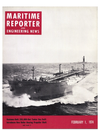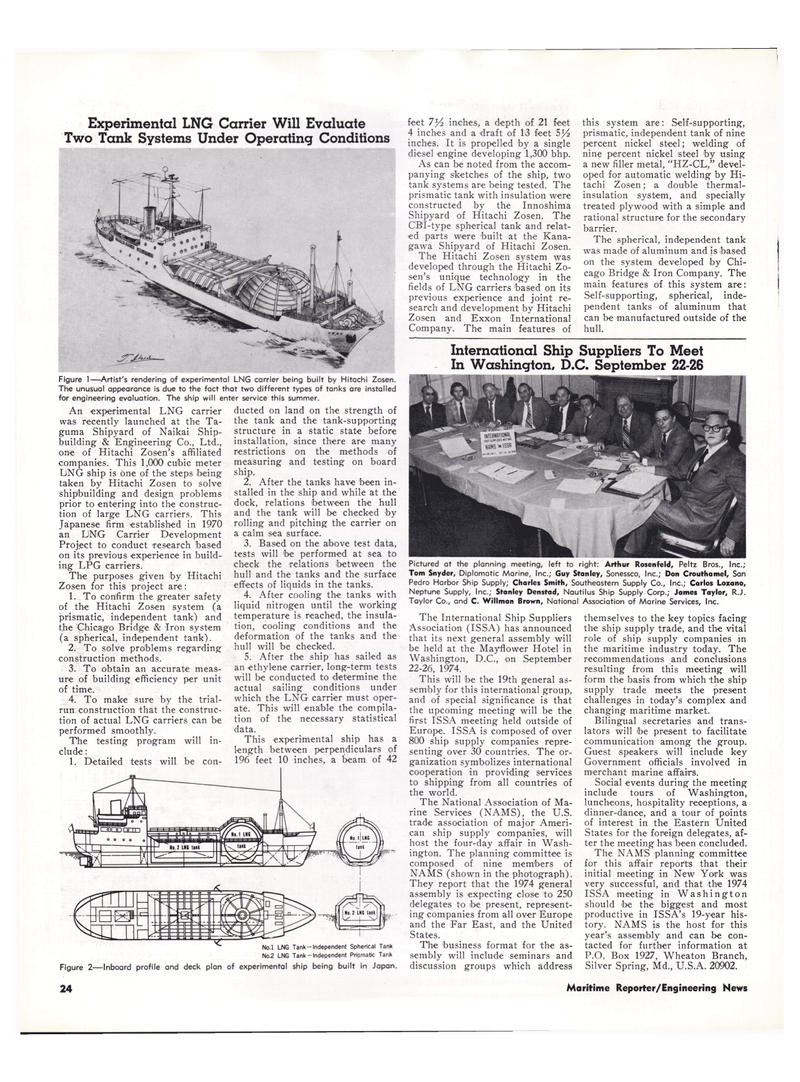
Page 21: of Maritime Reporter Magazine (February 1974)
Read this page in Pdf, Flash or Html5 edition of February 1974 Maritime Reporter Magazine
Experimental LNG Carrier Will Evaluate
Two Tank Systems Under Operating Conditions
Figure 1—Artist's rendering of experimental LNG carrier being built by Hitachi Zosen.
The unusual appearance is due to the fact that two different types of tanks are installed for engineering evaluation. The ship will enter service this summer.
An experimental LNG carrier was recently launched at the Ta- guma Shipyard of Naikai Ship- building & Engineering Co., Ltd., one of Hitachi Zosen's affiliated companies. This 1,000 cubic meter
LNG ship is one of the steps being taken by Hitachi Zosen to solve shipbuilding and design problems prior to entering into the construc- tion of large LNG carriers. This
Japanese firm established in 1970 an LNG Carrier Development
Project to conduct 'research based on its previous experience in build- ing LPG carriers.
The purposes given by Hitachi
Zosen for this project are: 1. To confirm the greater safety of the Hitachi Zosen system (a prismatic, independent tank) and the Chicago Bridge & Iron system (a spherical, independent tank). 2. To solve problems regarding construction methods. 3. To obtain an accurate meas- ure of building efficiency per unit of time. 4. To make sure by the trial- run construction that the construc- tion of actual LNG carriers can be performed smoothly.
The testing program will in- clude : 1. Detailed tests will be con- ducted on land on the strength of the tank and the tank-supporting structure in a static state before installation, since there are many restrictions on the methods of measuring and testing on board ship. 2. After the tanks have been in- stalled in the ship and while at the dock, relations (between the hull and the tank will be checked by rolling and pitching the carrier on a calm sea surface. 3. Based on the above test data, tests will 'be performed at sea to check the relations between the hull and the tanks and the surface effects of liquids in the tanks. 4. After cooling the tanks with liquid nitrogen until the working temperature is reached, the insula- tion, cooling conditions and the deformation of the tanks and the hull will be checked. 5. After the ship has sailed as an ethylene carrier, long-term tests will be conducted to determine the actual sailing conditions under which the LNG carrier must oper- ate. This will enable the compila- tion of the necessary statistical data.
This experimental ship has a length between perpendiculars of 196 feet 10 inches, a beam of 42
No.l LNG Tank-Independent Spherical Tank
No.2 LNG Tank-Independent Prismatic Tank
Figure 2—Inboard profile and deck plan of experimental ship being built in Japan. feet inches, a depth of 21 feet 4 inches and a 'draft of 13 feet Sx/2 inches. It is propelled by a single diesel engine developing 1,300 bhp.
As can be noted from the accom- panying sketches of the ship, two tank systems are being tested. The prismatic tank with insulation were constructed by the Innoshima
Shipyard of Hitachi Zosen. The
CBI-type spherical tank and relat- ed parts were built at the Kana- gawa Shipyard of Hitachi Zosen.
The Hitachi Zosen system was developed through the Hitachi Zo- sen's unique technology in the fields of LNG carriers based on its previous experience and joint re- search and development by Hitachi
Zosen and Exxon International
Company. The main features of this system are: Self-supporting, prismatic, independent tank of nine percent nickel steel; welding of nine percent nickel steel 'by using a new filler metal, "HZ-OL," devel- oped for automatic welding by Hi- tachi Zosen; a double thermal- insulation system, and specially treated plywood with a simple and rational structure for the secondary barrier.
The spherical, independent tank was made of aluminum and is based on the system developed by Chi- cago Bridge & Iron Company. The main features of this system are:
Self-supporting, spherical, inde- pendent tanks of aluminum that can be manufactured outside of the hull.
International Ship Suppliers To Meet
In Washington, D.C. September 22-26
Pictured at the planning meeting, left to right: Arthur Rosenfeld, Peltz Bros., Inc.;
Tom Snyder, Diplomatic Marine, Inc.; Guy Stanley, Sonessco, Inc.; Don Crouthamel, San
Pedro Harbor Ship Supply; Charles Smith, Southeastern Supply Co., Inc.; Carlos Lozano,
Neptune Supply, Inc.; Stanley Denstad, Nautilus Ship Supply Corp.; James Taylor, R.J.
Taylor Co., and C. Willman Brown, National Association of Marine Services, Inc.
The International Ship Suppliers
Association (ISSA) has announced that its next general assembly will be held at the Mayflower Hotel in
Washington, D.C., on September 22-26, 1974.
This will be the 19th general as- sembly for this international group, and of special significance is that the upcoming meeting will be the first ISSA meeting held outside of
Europe. ISSA is composed of over 800 ship supply companies repre- senting over 30 countries. The or- ganization symbolizes international cooperation in providing services to shipping from all countries of the world.
The National Association of Ma- rine Services (NAMS), the U.S. trade association of major Ameri- can ship supply companies, will host the four-day affair in Wash- ington. The planning committee is composed of nine members of
NAMS (shown in the photograph).
They report that the 1974 general assembly is expecting close to 250 delegates to ibe present, represent- ing companies from all over Europe and the Far East, and the United
States.
The business format for the as- sembly will include seminars and discussion groups which address themselves to the key topics facing the ship supply trade, and the vital role of ship supply companies in the maritime industry today. The recommendations and conclusions resulting from this meeting will form the basis from which 'the ship supply trade meets the present challenges in today's complex and changing maritime market.
Bilingual secretaries and trans- lators will be present to facilitate communication among the group.
Guest speakers will include key
Government officials involved in merchant marine affairs.
Social events during the meeting include tours of Washington, luncheons, hospitality receptions, a dinner-dance, and a tour of points of interest in the Eastern United
States for the foreign delegates, af- ter the meeting has been concluded.
The NAMS planning committee for this affair reports that their initial meeting in New York was very successful, and that the 1974
ISSA meeting in Washington should be the biggest and most productive in ISSA's 19-year his- tory. NAMS is the host for this year's assembly and can be con- tacted for further information at
P.O. Box 1927, Wheaton Branch,
Silver Spring, Md„ U.S.A. 20902. 23 Maritime Reporter/Engineering News

 20
20

 22
22
